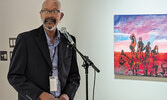At the Blyth Festival Art Gallery, Miller's work explores courage within tragedy
BY SHAWN LOUGHLIN
Owen Sound-based artist Tony Miller’s solo exhibition at the Blyth Festival Art Gallery, entitled “Descendants”, is just the latest steps in the journey of an artist who has exhibited all over the province and says he would create art even if he never made a dime as an artist.
Miller and his wife and fellow artist Lorrain Thomson were in Blyth for the opening of Miller’s show, which was on Saturday, July 13. However, Miller became, to the knowledge of Blyth Festival Art Gallery President Carl Stevenson and Festival Artistic Director Gil Garratt, the first artist to spend the week of his show at the Blyth Campground.
Stevenson said he had been working to have Miller exhibit at the gallery for some time after the two had connected in the Owen Sound area. The two met after Stevenson researched his genealogy and found he was, generations ago, connected to Black members of the Owen Sound community. He began to be part of Black history events in Grey County and became aware of Miller’s work.
Miller’s “Descendants” largely consists of his paintings and mixed-media pieces with a pair of lino prints from his first book, but he is experienced and accomplished in a number of disciplines, including making sculptures out of concrete.
Speaking with The Citizen, he said he loves to make art and would do it even if there wasn’t a cent to be made. Luckily for him, however, he’s been able to carve out a career for himself as an artist. He and Thomson co-own Bliss Studio in Owen Sound, which has become a place where they can both make and showcase their art.
Miller’s mother, however, was an artist, so there was always an easel around, he said. Then he would find art as a bit of an escape from the day-to-day realities of his childhood, which he says wasn’t very good, and as a place to belong in his later school years. He played baseball, he said, but he wouldn’t call himself a “jock” and he felt that the art community was where he found he fit best.
He would eventually accept art as something he could do for the rest of his life and potentially make a living doing it.
The “Descendants” show focused on the generations that came before him, the people who have come into the world since and how they have shaped the world around them. As the descendant of escaped slaves who settled at the last stop of the Underground Railroad in Owen Sound, many of the stories that Miller’s art tells are sad, tragic and harrowing. However, Miller says he chooses not to see them that way, or, he seeks to find the joy and courage in the tales.
Miller said at the opening night of his show that he seeks to tell the stories of courage of people who were persecuted for being Black and the changes their persistence and dignity would help bring about. This is the story of his art, but it’s also his own story. He said he receded into the background at times when he was younger and struggled with his identity at times, but he eventually began to embrace his identity and learn more about the bravery and success of Black members of the community.
There are some stories, of course, such as pieces that deal with slavery, that have no silver lining, but Miller says that the very nature of the show is to explore what it’s like to be part of a community, coming from people who have had these kinds of tragic experiences.
When he was a child, Miller felt that Black people were often characterized as being savage or uneducated in racist depictions in everyday entertainment. When he was able to look past that racism and find inspirational stories about the Black community, he learned more about his heritage and began to explore it through his art.
His work has since been included in more than 40 individual and group exhibitions, including “From the Soul: Caribana Art Exhibit” in 2010, which was presented at the Royal Ontario Museum in Toronto. The exhibition was curated by renowned African-Canadian artist and activist Joan Butterfield and it represented the country’s largest-ever single-juried display of works of art by African-Canadian artists. Forty-nine artists contributed a total of more than 160 pieces to the exhibition.
Miller was one of just a handful of the participating artists who were singled out for praise in a review by R.M. Vaughn of The Globe and Mail, who said, “One of my personal favourites in this vast collection was Tony K. Miller’s luminous, simultaneously festive and commemorative family portraits.”
As for Blyth, Miller said he really liked the community and was impressed with Memorial Hall and its Bainton Gallery, specifically, lauding its size and presentation, saying he likely could have brought a few more pieces to be part of the exhibition.
Miller’s show will close on Saturday, Aug. 10. The gallery will be open when the Festival’s box office is open.

